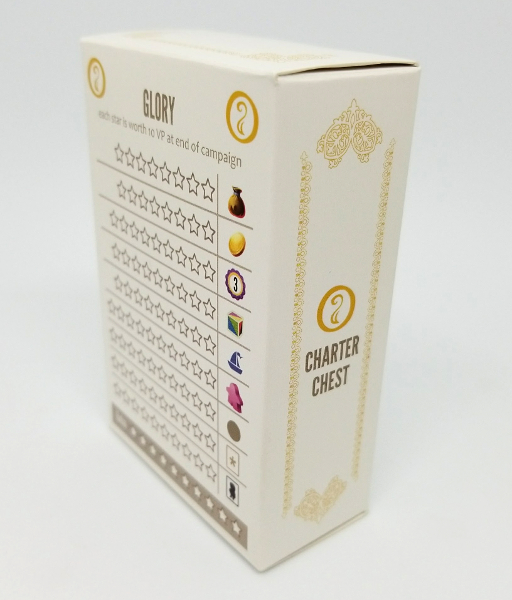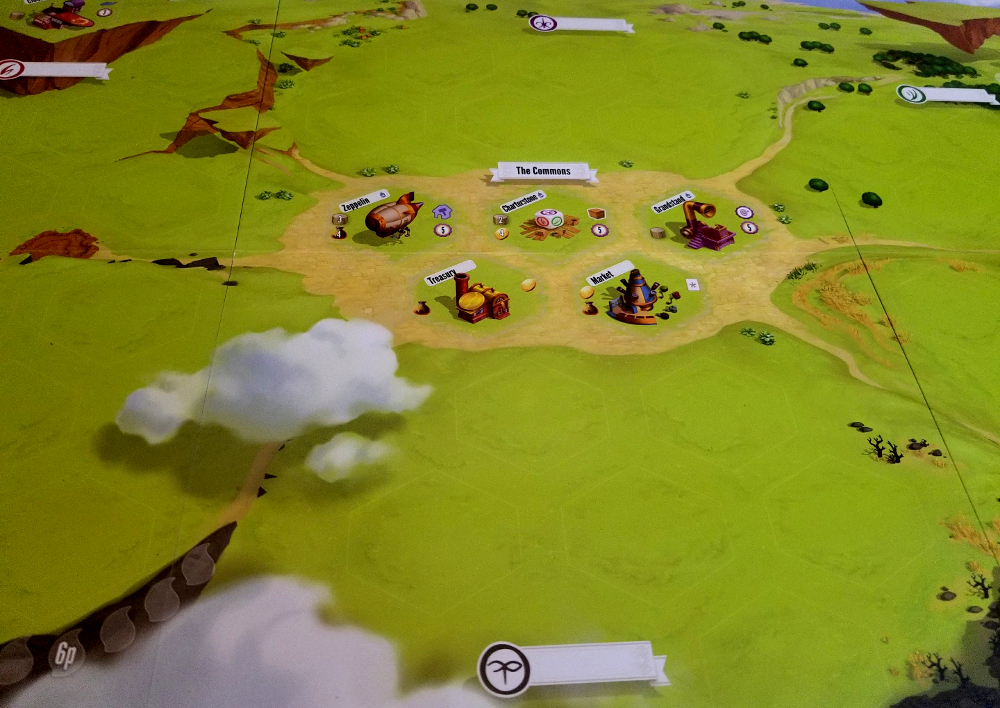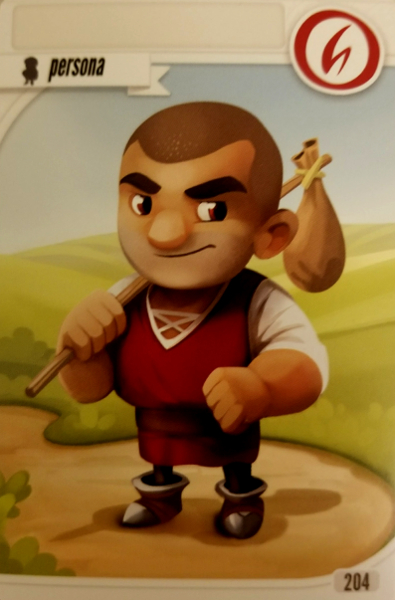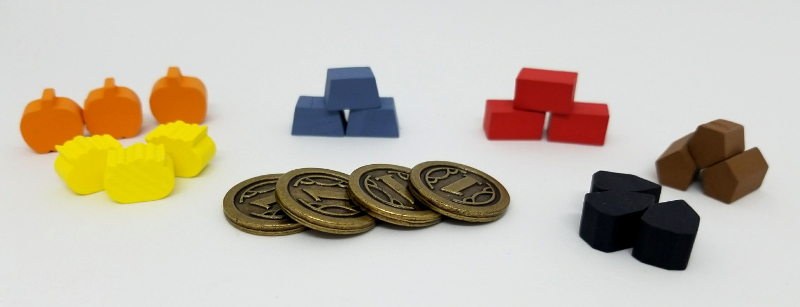Editor’s Note: This is a spoiler-free review of Charterstone.
Trembling with equal parts excitement and nerves, your hands fumble as you crack the wax seal – the Royal Seal of the Forever King himself – and read the scroll.
Congratulations, Our loyal subject, for this is a most momentous day! By this decree, you and your kin have been chosen for the settlement expedition into the Greengully Valley in the service of your King. Many new adventures and grand possibilities await you, and We are eager to see what you can accomplish in Our name.
Please collect what essentials you require and prepare to depart at once.
This was the day your family had dreamed of, and it was finally coming true! From simple farmers and miners to prosperous settlers. All you want is to make the benevolent Forever King happy…
The Premise
New lands await! At the decree of their leader, the Forever King, players lead factions to an undeveloped part of the kingdom. There, over the course of multiple seasons, they must procure resources, build structures, and adapt to the changing demands of their distant leader. Should they succeed, the Forever King will be very pleased. Probably.
The Rules
Charterstone is a legacy-style worker placement game. Over the span of twelve games players will have an influence on, and react to, an evolving board – one that changes and grows from one playthrough to the next.
To this end, Charterstone requires a moderate amount of table space to accommodate the central board, the Objective and Advancement boards, and space for the game’s seven core resources (such as wood, clay, and money). Additionally, space will be required for the Index (a box of additional components that incrementally adds new material to the campaign based on players’ decisions).
The basic structure of each playthrough remains largely the same from one game to the next, regardless of new components or mechanics that are introduced. At the beginning of the game, each player takes a character card, two workers, and 12 Influence Tokens from their supply. Each player also starts with an assortment of Advancement cards and/or resources. At the end of each game players carry a limited amount of materials into subsequent playthroughs.
Finally, five Advancement cards and three Objective cards are added to their respective boards. Advancements provide bonuses and special abilities and Objectives represent goals players can claim for VP. The start player is determined randomly by rolling the Charterstone die.
Turns in Charterstone consist of choosing to Place a Worker or to Retrieve Workers. To Place a Worker, the player selects any worker location on the board, pays the required activation costs (i.e. goods, money, and/or Influence Tokens), and resolves that space’s effect. If another worker is present at that location, that worker is ‘bumped’ back to its owner. Retrieving Workers allows the player to pick up all their workers from the board.
Like other worker placement games, Charterstone locations provide a variety of benefits, including resources, Advancements, etc. The most important actions are constructing buildings (adding a sticker to the board) and opening crates (unlocking more legacy content).
The length of each Charterstone game is determined by the Progress Track. Each time a building is added to the board, a crate is opened, or an objective is achieved, the Progress Track is advanced. Once it reaches the final space, the current round is finished and the game ends.
At that point, bonus VP is awarded according to the current end-game rules (which can change slightly throughout the campaign). Players earn Glory based on their score, and Glory carries over from one game to the next. It plays a role in some campaign decisions, but mostly is a factor in determining the resources each player begins the game with.
The player with the highest score is then rewarded as the most productive citizen of the town this season and earns some campaign points (which are tallied at the end of the twelfth game to determine the overall campaign winner).
Everyone else will need to buckle down and work harder in service of the Forever King. Or else.
Building Up The Blueprint
Charterstone’s core identity revolves around growth and development. This is felt from your first game and continues right on through to its conclusion. Starting with nothing, you will eventually create a board populated by your group’s collective decisions across 12 games as each player individually decides how to go about trying to win. And it is the depth of that decision-making potential where most of the game’s merit resides, cleverly implemented through legacy-driven gameplay.
Indeed, the degrees of strategic possibility and flexibility Charterstone delivers is impressive, with a high measure of agency over how to advance and improve your charter. This affords players ample opportunity to choose for themselves what kind of resource engine they’d like their charter to look like. Money? Lumber? Specific Advancement cards? The choice really is yours to make.
Beyond the fact that each charter favors a different core material, Charterstone doesn’t force anything on what players should build, or what order, allowing players to develop their engines as resources and card availability allows. And if your engine isn’t working to your liking, you always have the option of either modifying it or simply co-opting the engine of other players. In Charterstone, there are no copyrights.
Unsurprisingly, you can easily expect Tacticians to be part of this Greengully expedition, as the ability to modify, evolve, and optimize a system of their choosing over a dozen playthroughs is precisely their kind of game. Likewise, any game whose entire premise is to grow and improve their tableau as they see fit is exactly what Architects like to hear.
There is, however, a slight caveat to all this engine-building fervor: while change is an inevitable and encouraged part of the Charterstone ethos, ultimately the game favors slight alterations rather than completely overhauling your charter. In this game, finding your niche early and sticking with it is going to prove more rewarding than continually experimenting with new strategies. As such, while they may enjoy the variety provided in a post-campaign playthrough, Daredevils won’t particularly enjoy the twelve Charterstone games leading up to it.
Backward Progress
In Charterstone, the length of each game is determined by the aforementioned Progress track, which is directly impacted by players’ actions. This variability is generally a point in the game’s favor – it keeps each playthrough from feeling too stale and offers an opportunity to disrupt some long term strategies. Yet this also can lead to issues of inconsistent pacing – both from session to session and within individual playthroughs themselves. Namely, while there are very, very few ways to mess with other players in Charterstone, manipulating the pacing of the game is the one real exception.
Speeding up the game can indeed be a great way of ensuring that no one has the chance to build an engine so complex and wonderful that it can’t possibly lose. However, it can also unfortunately lead to some rather lackluster playthroughs. A single determined player can end the game far earlier than anyone else wants, and there’s little to nothing that can be done to prevent it.
This speaks to the one main issue with Charterstone: the relative lack of interaction between players means that catching up from behind or slowing down a runaway leader ranges from difficult to downright impossible.
With few exceptions, the game allows players to move freely, taking any space they’d like with minimal regard for what other players are doing. Players can slightly benefit from paying attention to the actions of their neighbors and acting accordingly, true, but between being able to bump workers and having over 40 action spaces to consider on a full board, there’s no significant way to adversely affect another player beyond the early games of the campaign.
This effectively means that if another player’s engine is working well, and yours isn’t, unless you develop a secondary engine, you are likely to fall behind…and stay behind.
With that said, don’t expect Strikers to stake a claim in Greengully anytime soon. They’ll appreciate the idea of trying to demonstrate that their strategy is better, but the inability to stymie a player (beyond prematurely ending the game) won’t sit well with them. Similarly, due to the game’s 60-90 minute length and lack of player interaction, Socializers will pass on this venture as well.
Dropping In For A Visit
The other area where Charterstone falters somewhat is with player additions. Although Charterstone provides the means to add and drop players over the course of the campaign, the game itself advocates maintaining the same players. Dropping players is a relatively simple task – the charter reverts to an inactive state – but adding players is not nearly as smooth.
For one, there’s the learning curve. Charterstone expertly guides you through the games by introducing new mechanics and strategies incrementally. This means that while it’s easy to teach, the game will take a playthrough or two for a newcomer to catch up strategically.
More importantly, Charterstone doesn’t provide enough compensation to put a new player on par with the veterans. This is worse the further into the campaign you attempt it. Put simply, if you are going to add a player, do it within the first few games. Even by the middle of the campaign, an incoming player will be at such a disadvantage due to a lack of resources, character cards, and most importantly – a charter that has been cultivated to the same degree as the active players – that it will leave them with a distinct disadvantage.
Architectural Prowess
Though its mechanics may have a few imperfections, the overall presentation of Chaterstone is anything but. The game is unequivocally beautiful, both visually and from a component perspective. The character art is diverse and adorable, giving off a warm and inviting atmosphere for you to jump into before your journey even begins. The cast of characters and their myriad incarnations feel cartoony and dreamlike, creating an excellent array of in-game flavor that’s kept on the lighter side while avoiding veering into silliness.
The same is true of the game’s physical quality. Like all Stonemaier titles, its components shine. Nearly every parcel of the Charterstone experience is well crafted, yet practical. This is particularly important given that how much of the game changes and is in constant use through at least twelve playthroughs. The components are simple where they need to be simple and complex where they need to be complex. Practically speaking, the buildings’ stickers work well as the primary legacy mechanic, and the Charterstone die is a unique addition. All told, Charterstone presents itself with an almost nostalgic vibe: it’s vaguely reminiscent of games played in childhood (with its deck of cards, single chunky wooden die, and bright colors), but without tapping directly into any one particular memory. It creates a sense of hazy familiarity that encourages you to look deeper, and it’s hard to resist that lure.
Because of this, Charterstone manages to do something rather difficult for a worker placement game: creating a lightweight yet worthwhile thematic experience that flows from one game to the next. You can certainly expect Immersionists to enjoy themselves campaigning through the world of Greengully, though their enthusiasm may wane slightly once the story comes to a close and the game reverts to being a more traditional worker placement affair.
The Takeaway
Charterstone set out to provide a new spin on the growing legacy genre, and on that fact alone it succeeds handily. Charterstone unfurls a cryptic blueprint on the table and invites the players to fill in the blanks themselves, providing an excellent blend of engine building and unexpected twists at every stage. Despite some issues of competitive interactivity (or lack thereof), the game has a knack of keeping you interested and engaged with board decisions on the one hand while making you wonder about what new secrets lay ahead on the other. Plus, Charterstone also successfully does what no legacy game has done before: leaving you with fully replayable and unique game map once the thrill of the storyline is over. With outstanding components, first-rate visuals, and multitude of mysteries to uncover throughout the campaign, Charterstone is a wonderful experience that is certainly worth exploring.
Charterstone is a product of Stonemaier Games.
Cardboard Republic Snapshot Scoring (Based on scale of 5):
Artwork: 4.5
Rules Clarity: 4.5
Replay Value: 4 during campaign / 3.5 after campaign
Physical Quality: 4.5
Overall Score: 4







